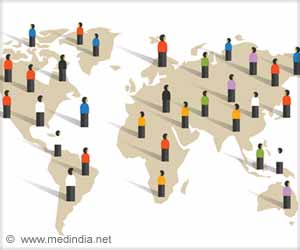The Nordic countries hog the top spots in regard to the women’s position too. Only last fortnight the world prosperity index had found them in the top league.
The Nordic countries hog the top spots in regard to the women’s position too. Only last fortnight the world prosperity index had found them in the top league.
For all the economic progress India is supposed to have made in recent years, the country ranks an abysmal 114th in the World Economic Forum’s Global Gender Gap Index 2009. And it is a list of 134 countries!“Countries that do not fully capitalize on one-half of their human resources run the risk of undermining their competitive potential. We hope to highlight the economic incentive behind empowering women, in addition to promoting equality as a basic human right,” said co-author Saadia Zahidi, Head of the Forum’s Women Leaders and Gender Parity Programme.
“Girls and women make up one half of the world’s population and without their engagement, empowerment and contribution, we cannot hope to achieve a rapid economic recovery nor effectively tackle global challenges such as climate change, food security and conflict,” said Klaus Schwab, Founder and Executive Chairman, World Economic Forum. “
The Forum works year-round with leaders on ways to close gender gaps through its Women Leaders and Gender Parity Programme, and this report underpins their work.” The Global Gender Parity Group, a community of highly influential leaders from business, politics, academia, media and civil society – 50% women and 50% men – seeks to share best practices and identify strategies to optimize the use of talent.
The report’s Index assesses countries on how well they are dividing their resources and opportunities among their male and female populations, regardless of the overall levels of these resources and opportunities.
• Nordic countries continue to have the smallest equality gaps between men and women
• Report demonstrates that engaging women equally with men in all aspects of life is imperative for economically competitive and prosperous societies
• In particular, for rapid, sustainable economic recovery from financial crisis, integrating women and girls imperative
Iceland (1) has claimed the top spot from Norway (3) which slipped to third position behindFinland (2). Sweden (4) completed the Nordic countries’ continued dominance of the top four.
Advertisement
The report notes with satisfaction that more than two-thirds have posted gains in overall index scores, indicating that the world in general has made progress towards equality between men and women, although there are countries that continue to lose ground.
Advertisement
Botswana (39) made the second biggest improvement of 26 places thanks to a major increase in labour force participation according to the latest data from the UNDP, plus greater wage equality for women. Japan’s (75) ranking improved by 25 places relative to last year largely due to increases in the proportion of women in professional and technical positions as well as legislators, senior officials and managers.
The United States (31) fell by three places, owing to minor drops in the participation of women in the economy and improvements in the scores of previously lower-ranking countries.
Germany (12) and the United Kingdom (15) again slipped down the Index this year. Switzerland (13) advanced for a second consecutive year as a result of greater female participation in the economy. Italy (72) continues to hold one of the lowest positions among European countries and dropped three spots relative to 2008 due to persistently poor scores in economic participation.
At the bottom part of the rankings, India (114), Bahrain (116), Ethiopia (122), Morocco (124), Egypt (126) and Saudi Arabia (130) all made improvements relative to their rankings last year. This was driven mainly by small improvements in the economic participation of women. Iran (128), Turkey (129), Pakistan (132) and Yemen (134), already at the bottom of the rankings, displayed an absolute decline relative to their performance in 2008.
The Republic of Korea and Mongolia were among the top countries to narrow wage gaps, while in Austria and Belgium income disparities widened the most. Women entering senior official, managerial and legislator roles shot up most in Japan and Uganda, while Croatia and Costa Rica saw these gaps widen markedly.
The Global Gender Gap Report measures the size of the gender inequality gap in four critical areas:
1) Economic participation and opportunity – outcomes on salaries, participation levels and access to high-skilled employment
2) Educational attainment – outcomes on access to basic and higher level education
3) Political empowerment – outcomes on representation in decision-making structures
4) Health and survival – outcomes on life expectancy and sex ratio
The Index’s scores can be interpreted as the percentage of the gap that has been closed between women and men.
“Out of the 115 countries covered in the report since 2006, more than two-thirds have posted gains in overall index scores, indicating that the world in general has made progress towards equality between men and women, although there are countries that continue to lose ground. We have included a section on the dynamics of the gender gap and found that progress is achieved when countries find ways to make marriage and motherhood compatible with the economic participation of women,” said co-author Ricardo Hausmann, Director of the Centre for International Development at Harvard University, USA.
“The Global Gender Gap Report demonstrates that closing the gender gap in all aspects of life provides a foundation for a prosperous and competitive society. Leaders should act in accordance with this finding as they rebuild their battered economies and set them on course for sustainable long-run growth,” said co-author Laura Tyson, Professor of Business Administration and Economics, University of California, Berkeley, USA.
As for India, only 14 per cent of the companies surveyed have 40 per cent or more women among their employees. These women employees are mainly present at the entry and middle levels of management, while very few women attain senior management level.
Most companies do not track salary gaps, despite the clear wage gaps between women and men only 4 per cent of the companies surveyed are attempting to monitor salary gaps.
"Women, as half of the human capital of India, will need to be more efficiently integrated into the economy in order to boost India's long-term competitive potential. The World Economic Forum's survey of some of the biggest companies in India shows that, to achieve this integration, Indian companies will need to set targets, improve policies to close salary gaps and promote work-life balance," said Saadia Zahidi.
India holds last place among the BRIC countries on the Index, behind Russia (51), China (60) and Brazil (82). In South Asia, the sub-continent is in second-to-last place behind Sri Lanka and Bangladesh and ahead of Pakistan. Sri Lanka leads in the rankings by far, holding 16th position, followed by Bangladesh (94), Maldives (100), Nepal (110).
In Economic Participation and Opportunity, India is ranked 127th, in educational attainment 121st,
in health and survival 131st, but some solace, in terms of political empowerment, it is in the top league, 24th.
India has closed 93 per cent of its health gender gap, 84 per cent of its education gap, 41 per cent of its economic participation gap and 27 per cent of the political empowerment gender gap according to the report.
India's middle class will see rapid growth off a very low base, but the country is likely to remain constrained by women's relatively low status, at least for the next 10 to 15 years.
Watch the video interview with Co-author Saadia Zahidi: http://www.youtube.com/watch?v=du62A89hgsU
Source-Medindia
GPL








